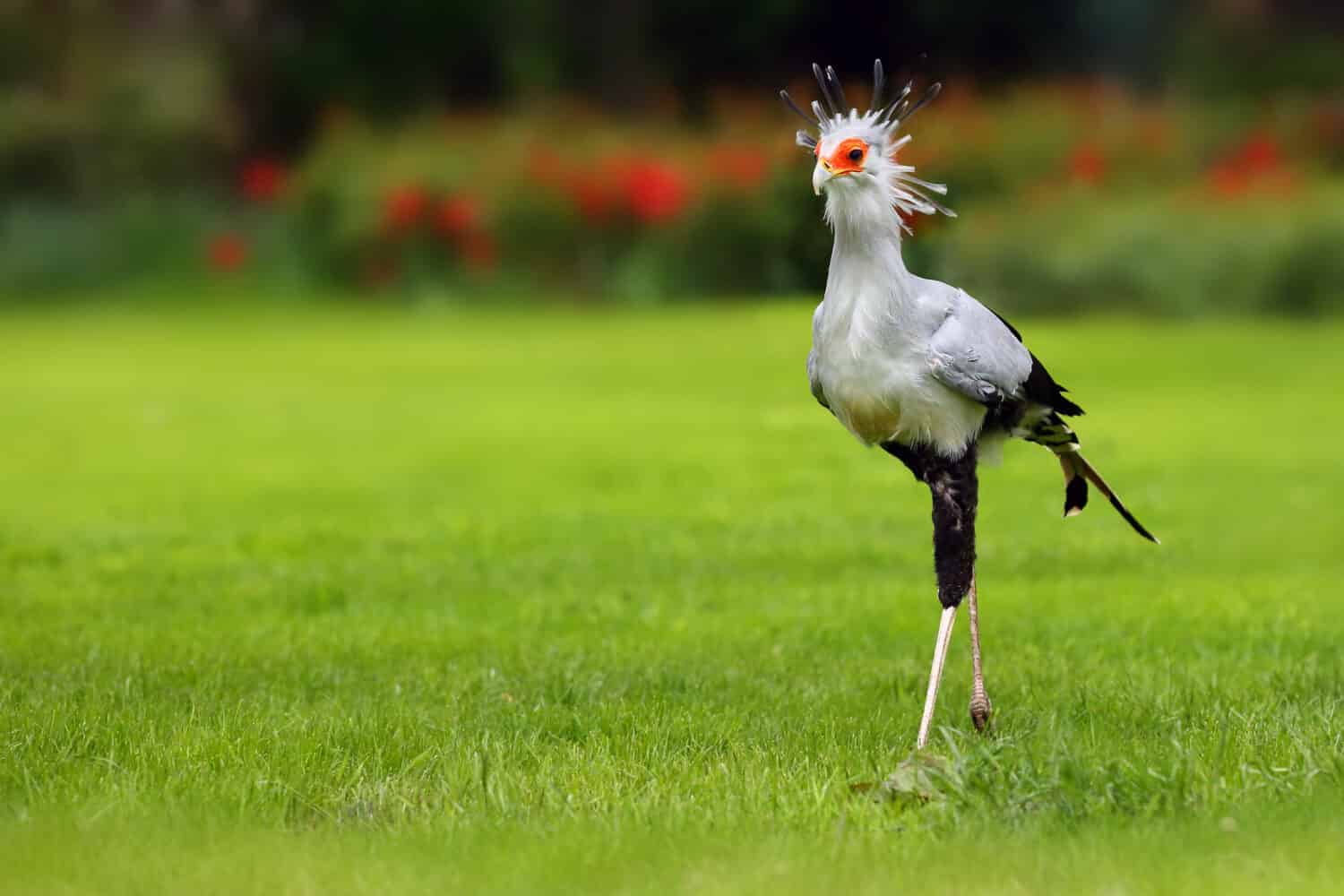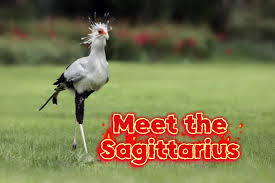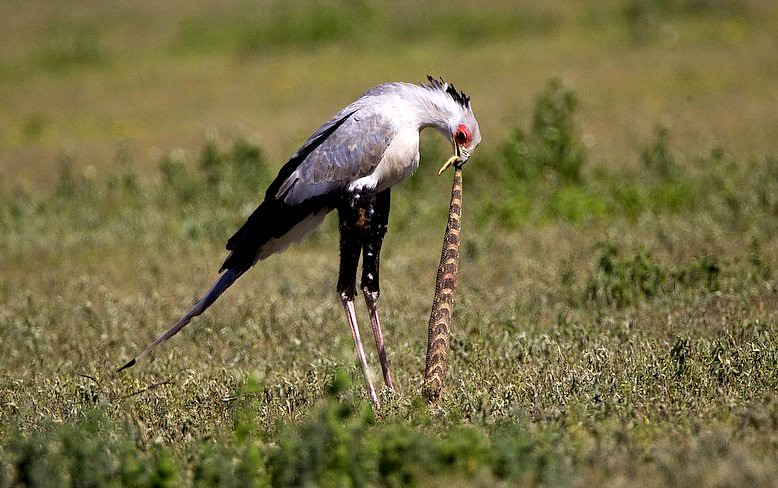The SECRETARYBIRD — Fashionable Yet Fierce

The SECRETARYBIRD — Fashionable Yet Fierce
If there were ever a bird that could strut down the runway in Paris Fashion Week and then turn around to take down a venomous snake in seconds, it would be the Secretarybird. With its long, stilt-like legs, dramatic crest of black feathers, and piercing gaze, this African predator is a study in contrasts — elegant yet dangerous, poised yet ruthless.
The Secretarybird (Sagittarius serpentarius) is one of the most unique raptors in the world, not only because of its striking appearance but because of how it hunts. Found mainly in the open grasslands and savannas of sub-Saharan Africa, this bird stands tall — literally — at an average height of 1.2 to 1.4 meters (about 4.0 to 4.6 feet). Imagine a bird almost as tall as a child, stalking across the plains like a runway model with lethal intent.
But here’s the twist: while most birds of prey rely on aerial dives, razor-sharp talons, and swift mid-air strikes, the Secretarybird prefers a ground assault. Its most dangerous weapon isn’t its beak — it’s its legs.
A Fashion Statement From Nature
From a distance, the Secretarybird looks almost comical. Its long, crane-like legs are covered in black scales, and its wings have white and black patterns that contrast beautifully against its pale grey body. But the real showstopper is its head — a sleek crown of elongated black feathers that stand upright, giving the bird a look that is equal parts regal and punk rock.
These “plumes” are the source of its curious name. In the 18th and 19th centuries, European observers likened the feathers to the quill pens that secretaries used to tuck behind their ears. Over time, “Secretarybird” stuck, even though the bird has no secretarial duties (unless you count filing away snakes in its stomach).
When the sun hits just right, the contrast of grey, black, and white feathers, combined with its fiery orange face patch and intense yellow eyes, makes the Secretarybird look like it’s perpetually ready for a high-fashion photoshoot. Yet beneath the beauty lies a lethal predator.
The Hunter With Deadly Legs
The Secretarybird’s legs are not just for show — they are precision-engineered weapons. Each limb can deliver a lightning-fast stomp with forces exceeding five times the bird’s body weight. This means that in less than a blink, the Secretarybird can crush a small mammal, break a snake’s spine, or pin down prey until it stops moving.
Researchers have measured their kicks in controlled environments and found them capable of striking with astonishing speed — up to 50 milliseconds from initiation to impact. For context, that’s faster than most human reaction times, making it almost impossible for prey to evade once targeted.
The bird’s primary diet includes snakes (both venomous and non-venomous), lizards, insects, small mammals, and occasionally birds. When tackling venomous snakes like cobras or puff adders, the Secretarybird uses its long legs to maintain a safe distance, striking repeatedly until the snake is incapacitated. Then, with calculated precision, it swallows its meal whole.
A Predator of the Plains
The Secretarybird’s habitat choice — open grasslands and savannas — isn’t just random. This environment allows it to spot prey from a great distance, thanks to its exceptional eyesight. Like an eagle, the Secretarybird can see small movements in the grass from hundreds of meters away.
Its hunting strategy often involves long, deliberate walks across its territory. It can cover more than 30 kilometers (about 18 miles) in a single day, methodically scanning the ground for any signs of life. Once prey is spotted, the bird’s walk transforms into a sprint, followed by a sudden, devastating kick.
In the wild, this method has earned the Secretarybird both respect and fear. Other animals give it space, not because it’s aggressive toward them, but because everyone seems to understand — this bird means business.
Courtship and the Next Generation
For all its fierceness in hunting, the Secretarybird is surprisingly tender when it comes to courtship and raising young. Pairs often form long-term bonds, performing synchronized aerial displays during the breeding season. These displays involve soaring together in wide circles, calling to each other, and occasionally engaging in playful “chases” through the air.
Once a mate is chosen, the pair builds a large nest high in an acacia or thorn tree. These nests can be enormous, reaching up to 2.5 meters (over 8 feet) in diameter and reused year after year, with fresh material added each season.
The female lays between one to three eggs, and both parents share incubation duties. After hatching, the chicks are fed a steady diet of small animals, carefully torn into bite-sized pieces. Within a few weeks, the chicks begin practicing their stomping skills inside the nest, instinctively preparing for their future as hunters.
Cultural Significance and Symbolism
The Secretarybird isn’t just a biological marvel; it holds deep cultural importance in Africa. It is featured prominently on the coat of arms of South Africa, where it symbolizes protection against enemies. Its image has also appeared on stamps, currency, and various national emblems.
In folklore, the bird is often admired for its courage and its snake-killing abilities. Many African communities regard it as a guardian of the land, a protector that keeps dangerous reptiles at bay. Spotting a Secretarybird in the wild is considered a sign of good luck in some regions.
Conservation Status — A Rising Concern
While the Secretarybird remains relatively widespread, its population is declining due to habitat loss, agricultural expansion, and human disturbance. The International Union for Conservation of Nature (IUCN) currently lists it as Endangered.
The loss of grassland ecosystems and the spread of intensive farming reduce the open spaces the bird needs for hunting. Additionally, electrocution from power lines and collisions with vehicles pose threats in certain regions.
Conservation efforts include protecting key grassland habitats, creating wildlife corridors, and raising public awareness about the bird’s ecological role. Several African reserves actively monitor and protect Secretarybird populations to ensure their survival for generations to come.
The Secretarybird in Popular Media
Its dramatic looks and unusual hunting style have made the Secretarybird a star beyond the wild. Wildlife documentaries often feature it in slow-motion sequences, showing its iconic stomps in mesmerizing detail. The bird has also appeared in illustrated children’s books, nature magazines, and even inspired fictional creatures in movies and video games.
Some fashion designers have cited the Secretarybird’s bold black-and-white color palette and distinctive “eyeliner” markings as inspiration for runway looks. It’s a reminder that nature has always been the original artist.
Why the Secretarybird Stands Out in the Bird World
When you think of birds of prey, eagles, hawks, and owls usually come to mind. But the Secretarybird breaks almost every stereotype in the raptor handbook:
-
It hunts on foot, not from the air.
-
Its primary weapon is its legs, not its talons.
-
It combines the height of a stork with the predatory skill of an eagle.
-
It’s as much a fashion icon as it is a fierce hunter.
This combination makes it a true one-of-a-kind species — proof that evolution doesn’t follow a single path, but instead experiments with form and function to create something extraordinary.
The Stomp Heard Around the World
Perhaps the most famous aspect of the Secretarybird’s reputation is its fight with snakes. Videos have gone viral showing the bird dispatching venomous serpents with methodical, almost surgical precision. Its long legs keep it out of striking distance, while its feet slam down with devastating force.
Herpetologists have even studied the bird’s effectiveness in snake control, noting its potential ecological role in keeping venomous snake populations in check. In areas where Secretarybirds are abundant, farmers sometimes consider them allies, protecting livestock and people from dangerous bites.
A Day in the Life of a Secretarybird
Morning begins with the bird scanning the horizon from a tree perch. Once the sun warms the plains, it glides down to the grasslands and begins its patrol. Step after deliberate step, it searches for the slightest movement. Grasshoppers leap, rodents scurry, and occasionally, a snake slides silently through the grass — and that’s when the chase begins.
By midday, the Secretarybird may have walked for hours, covering miles in search of food. After a successful hunt, it often takes time to preen its feathers, maintaining its immaculate appearance. The rest of the day is spent continuing its patrol or returning to the nest if chicks are waiting to be fed.
In the End — Beauty and Power in Perfect Balance
The Secretarybird is living proof that nature’s designs can be both beautiful and deadly. Its elegance captivates wildlife photographers, while its strength inspires awe in scientists and nature lovers alike. Standing tall on the African plains, it is both a guardian and a predator, a symbol of grace and raw power.
Next time you see a picture of the Secretarybird — whether in a magazine spread, a wildlife documentary, or a national emblem — remember that beneath the stylish plumes and slender legs lies one of the most formidable hunters in the bird kingdom. It’s a reminder that in nature, beauty and danger often walk hand in hand… or in this case, stride on long legs across the golden grass.











